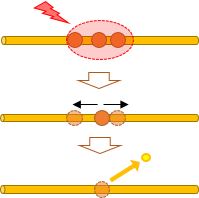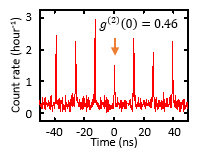Research:Room-temperature single photon emission from air-suspended carbon nanotubes
Single photon emitters are an essential element in the field of quantum information processing including quantum cryptography and quantum communication. For further development and practical applications of such technologies, ideal single photon emitters are needed. In conventional single photon emitting materials, however, it is difficult to simultaneously achieve high efficiency, telecom wavelength emission, and room-temperature operation.
Here we demonstrate single photon generation at room temperature and telecom wavelength using air-suspended carbon nanotubes, where exciton diffusion length is long and therefore exciton-exciton annihilation occurs very efficiently.

By irradiating a pulsed laser, multiple excitons are generated in a carbon nanotube, and then they diffuse along the nanotube axis. If the diffusion length is longer than or comparable with the laser spot size, it is expected that all the excitons interact with another with a high probability. Exciton-exciton annihilation occurs repeatedly, reducing the number of excitons to unity. The last surviving exciton is no longer involved in exciton-exciton annihilation, and it can emit a single photon.

Such a mechanism for single photon generation is examined by performing autocorrelation measurements using a Hanbury-Brown Twiss setup. We observe clear photon antibunching, where a peak count at τ=0 is smaller than other peaks, and we obtain a degree of antibunching smaller than 0.5, indicating single photon generation.
In this work, we use individual carbon nanotubes with emission wavelengths ranging from 1280 nm to 1510 nm and show that all of them exhibit photon antibunching, which means that wavelength selectable room-temperature single photon emitters are achieved. Furthermore, in contrast to other single photon emitting materials, our air-suspended carbon nanotubes have high compatibility with conventional microfabrication techniques due to their micron-scale length, leading to new design strategies for quantum photon sources.
To learn more about this work, please refer to:
Room-temperature single photon emission from micron-long air-suspended carbon nanotubes
Phys. Rev. Applied
8, 054039 (2017).
![]()